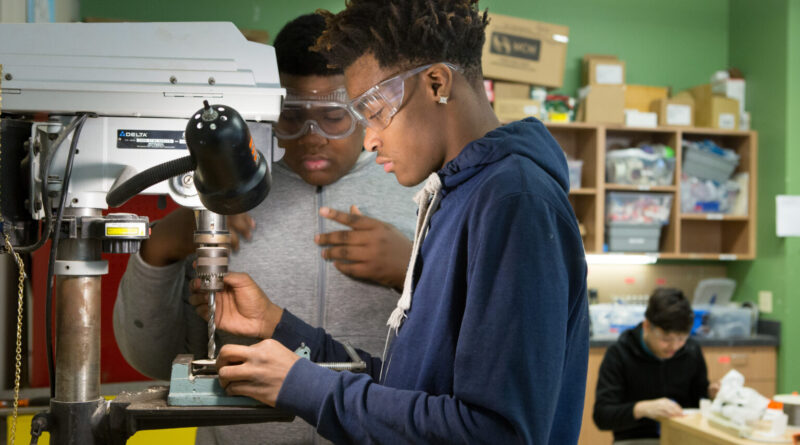Connecting Learning and Careers
In a globally competitive world of work, students need the skills and knowledge that employers demand and the ability to continue to learn across their lifetimes. At the same time, employers and communities need a healthy pipeline of skilled talent and a workforce that sustains the economic viability of companies and the prosperity of cities, states and regions. Connecting Learning and Careers.
Most American high school students, on both college and career pathways, are not receiving an education that delivers high-quality preparation for either path after graduation, and work-based learning in particular isn’t making the grade. Multiple surveys in recent years show that a large majority of business executives and hiring managers believe there is a significant gap between the skills they need and those that workers possess.
Business Impact
In our own state of North Carolina, we see the business impact of the choices made in the state’s education system. Once tops in the nation for business, North Carolina was recently dethroned by its neighbor to the north, Virginia. Experts and media outlets point to Virginia’s elite education system as making the difference.
It’s past time to address this challenge, provide students with real entry to high-quality careers and give them meaningful opportunities for financial security through collaboration between education and business leaders, both in the Tarheel State and nationwide.
In Guilford County, North Carolina, future-focused partnerships between local industry and public schools are pushing in that direction, getting more students into career pathways in high-demand fields. The effort is offering young people a chance to gain the qualifications they need to successfully participate in the growing number of careers that require expertise in areas such as advanced manufacturing, cloud computing and AI, and logistics, both locally and nationally.
In 2018, Guilford County Schools and local employers convened a blue-ribbon task force that included representatives of industry, nonprofits and colleges to identify the high-growth sectors for our region. Through a comprehensive local employment and skills needs assessment, this coalition created a vision and game plan for career-connected education.
Signature Career Academies
Today, six Signature Career Academies offer state-of-the-industry learning environments that equip students with skills and credentials in artificial intelligence, robotics, advanced manufacturing, cybersecurity, biotechnology, global logistics and supply chain management, and more.
The experiences students have in the classroom, the technology and tools they use and the on-the-job training aspects of the curriculum are shaped by input from local employers and practitioners in the field. Many students earn wages while they learn — and certain pathways provide full benefits as students spend three days on the job and two days in traditional classes. They graduate with highly desired credentials and qualifications, debt-free, ready to step into good-paying careers or further education.
Career exposure experiences start early for the district’s students, in upper elementary and middle school. Through a range of virtual “Get Into Industry” tours; workforce symposia; AI skill simulators; and industry-specific computer applications that let students practice what they would do on the job, young people can see and feel what it means to work in a particular field. The objective is to spark curiosity that can uncover personal passions and, ultimately, career aspirations. And if students change their minds, there are multiple ways throughout high school for them to switch programs, try another industry or field and get into a new pathway.
Structured Programs
More than 300 experienced instructors lead students through structured programs that mix classroom, virtual and on-the-job learning. To stay up to date on the latest advances and practices in their industry, instructors spend time during the summer in the field, bringing new knowledge and expertise back to their students and ensuring that programming stays current.
The results speak for themselves. In 2020-21, amid the pandemic, Guilford County students earned 2,966 industry-recognized credentials. The following school year, that number jumped to 7,118. This past school year, students earned 10,766 credentials, a more than threefold increase.
In a moment when communities nationwide are struggling with chronic absenteeism and job satisfaction among younger workers is markedly lower than that of other age groups, enabling young people to pursue fields and pathways of their choice makes education more relevant and, therefore, more engaging. Research shows that because of its relevance and engagement, high-quality career and technical education — like that in our Signature Career Academies — improves attendance and student outcomes. It also produces higher graduation rates. This past school year, the district’s four-year graduation rate hit an all-time high of 92.2%.
High Quality Credentials
Our high-quality credentialing offers district students evidence of skill attainment while providing a powerful signal to employers — as well as those considering moving to the area — that the region is positioned to have a skilled workforce that endures, and a local economic base that is resilient and future-focused.
When young people have access to high-quality, career-connected learning, income inequality is reduced and communities flourish.
A quarter of the way into the 21st century, and more than 40 years after warnings of A Nation at Risk, business and education leaders can help make learning relevant and engaging for students by working together, in ways both big and small. Doing so is not simply an investment in our students — it’s an investment in the future of America’s neighborhoods, towns, cities, states and the entire nation.
Source: Connecting Learning and Careers
Connecting Learning and Careers to Build the Workforce of Tomorrow
Oakley and Suggs: In North Carolina, education and business are working together to prepare students for good-paying, high-demand jobs. https://www.gcsnc.com/
https://www.techedmagazine.com/category/news-by-industry/

